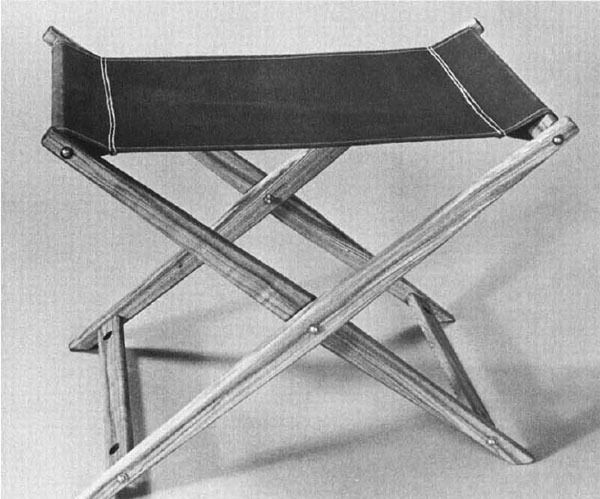Folding Stool With Tray
Knockdown design for a dual-purpose project
Synopsis: Tage Frid describes his design and making of a folding stool in ash that measures 1-3/4 inches when folded. Included are photos and detailed plans of the folding stool with tray.
I was asked to design a folding stool that would be light, take up little space when folded, and serve as the base for a tray. In addition, any parts broken during service would have to be easily replaceable. When the stool was finished it weighed 4 lb., and measured 1 in. folded. Nothing has broken yet, so I haven’t had to take it apart, but I could if I wanted to and it would go back together good as new.
I made the stool from ash. If I had used a weaker wood, I would have added to the thicknesses and widths for strength. The seat can be either leather or canvas. The one shown is canvas, with a single row of stitches to make a hem at the edges and a double row to hold the 3-in. overlap.
The stretchers can be held to the legs with either T-nuts or barrel nuts and 3/16-in. stove bolts. The stool shown here has T-nuts, which leave the holes in the stretchers open. Barrel nuts would have filled the holes and looked like metal plugs. Where the stretchers butt against the legs there’s a hidden dowel (or a steel pin) that keeps the stretchers from turning. A washer between the legs where they cross allows the stool, to fold easily, and double nuts are locked together so they don’t have to be drawn too tight. If a tight single nut were used, the stool wouldn’t fold. Washers under the bolt heads protect the wood.
The legs are identical except for the angle on the foot—the angle makes it a right leg or a left, to keep the dowel holes inside. Mill the leg blanks, square them and cut them to exact length. Set up the drill press with stops to locate the holes, and then drill them all. Notice that the holes for the dowels or steel pins don’t go through—make these holes 3/8-in. deep. After you’ve drilled the holes, taper the legs with a taper jig on the tablesaw or on the bandsaw. Cut a little wide so you can run the edges over the jointer to remove the saw marks, and then cut the foot angle.
The stretchers are all the same length. I made the bottom stretchers 1/8-in. wider than the top because people have a tendency to put their feet on them when they sit on a stool, but the stretchers could be all the same size. Mill them out and cut them to length, then use a stop on the drill press to make the holes for the T-nuts or barrel nuts. For T-nuts, make 5/8-in. holes; for barrel nuts, use 1/2-in. holes. Of course, regular nuts could be used if the others aren’t available, but barrel nuts are easy to make. My students and I use them a lot—they make an attractive and strong joint if a piece has to be disassembled. They can be of 1/2-in. cold-rolled steel, aluminum, brass, or other rod stock.
From Fine Woodworking #36
For the full article, download the PDF below:
Fine Woodworking Recommended Products

Suizan Japanese Pull Saw

Circle Guide

Drafting Tools






















Comments
39 year after this was first published I just made these stools closly following Tage Frid's design. Hard to believe I have been reading FineWoodworking for more than 40 years.
I needed a pair of stools to match a camping table that I cleate mount to our off road teardrop trailers heavy duty wheel fenders. That puts the table at near counter height, 34". So I had to add 4 inches of seat height to Tage's original design.
I used Hickory and finished in tung oil. Leg stock went from 3/4
thickness to 1". As the leaver arm acting on the legs center pivot was increased I felt I also needed to increase the center width from 1 &5/8" to 2". Leg Length increased from 27.5" to 32" I did not want a leg spliting when I drop my heavy backside on it. I then tapered the legs to 1" rather than Tage's 7/8ths. Stretcher plan remained the same except I Used 3/4 vs 5/8 stock. I manufactured the barell nuts out of nominal 1/2" diameter round aluminum bar stock. This was a headache as the bar stock was actualy 33/32" in dameter. I had to carefully sand out the receiving hole for each of 16 barell nuts. My wife Cindy produced the canvas sling seats. My version is certainly heavier, but they are pretty and provide confidence and stability when seated at their 22" height. It is the length of the sling seat which determines the height of the chair so plan that length just as carefully as the woodwork.
Log in or create an account to post a comment.
Sign up Log in